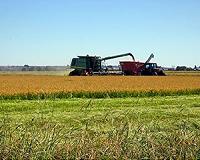 |
Washington DC (SPX) Mar 18, 2011 A U.S. Department of Agriculture (USDA) grass breeder has rediscovered a forage grass that seems just right for today's intensive rotational grazing. A farmer's report of an unusual forage grass led Michael Casler, an Agricultural Research Service (ARS) geneticist at the agency's U.S. Dairy Forage Research Center in Madison, Wis., to identify the grass as meadow fescue. Meadow fescue has been long forgotten, although it was popular after being introduced about 50 to 60 years before tall fescue. ARS is USDA's principal intramural scientific research agency. Casler has developed a new variety of meadow fescue called Hidden Valley, and its seed is being grown for future release. Non-toxic fungi called endophytes live inside meadow fescue, helping it survive heat, drought and pests. Unlike the toxic endophytes that inhabit many commercial varieties of tall fescue and ryegrass, meadow fescue does not poison livestock. Charles Opitz found the grass growing in the deep shade of a remnant oak savannah on his dairy farm near Mineral Point, Wis. He reported that the cows love it and produce more milk when they eat it. Casler used DNA markers to identify Opitz's find. Meadow fescue is very winter-hardy and persistent, having survived decades of farming. It emerged from oak savannah refuges to dominate many pastures in the Midwest's driftless region, named for its lack of glacial drift, the material left behind by retreating continental glaciers. Casler and his colleagues have since found the plant on more than 300 farms in the driftless region of Wisconsin, Iowa and Minnesota. Geoffrey Brink, an ARS agronomist working with Casler, discovered that meadow fescue is 4 to 7 percent more digestible than other cool-season grasses dominant in the United States. In another study, meadow fescue had a nutritional forage quality advantage over tall fescue and orchardgrass that may compensate for its slightly lower annual yield further north, as reported in the Agronomy Journal. Also, the yield gap begins to close with the frequent harvesting involved in intensive grazing.
Share This Article With Planet Earth
Related Links Agricultural Research Service (ARS) Farming Today - Suppliers and Technology
 Natural Sequence Farming
Natural Sequence FarmingWashington DC (SPX) Mar 18, 2011 Improving land management and farming practices in Australia could have an effect on global climate change, according to a study published in the International Journal of Water. Natural Sequence Farming is a descriptor used when sustainable agriculture mimics the once highly efficient functions of the Australian landscape. NSF pioneer Peter Andrews of Denman in New South Wales and coordina ... read more |
|
| The content herein, unless otherwise known to be public domain, are Copyright 1995-2010 - SpaceDaily. AFP and UPI Wire Stories are copyright Agence France-Presse and United Press International. ESA Portal Reports are copyright European Space Agency. All NASA sourced material is public domain. Additional copyrights may apply in whole or part to other bona fide parties. Advertising does not imply endorsement,agreement or approval of any opinions, statements or information provided by SpaceDaily on any Web page published or hosted by SpaceDaily. Privacy Statement |